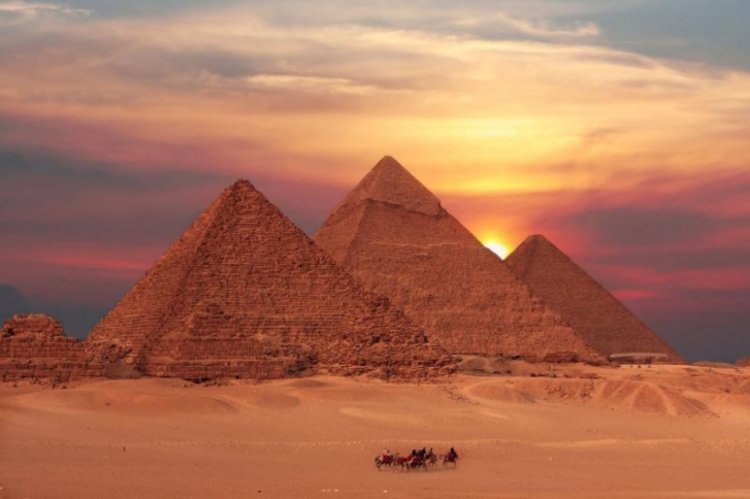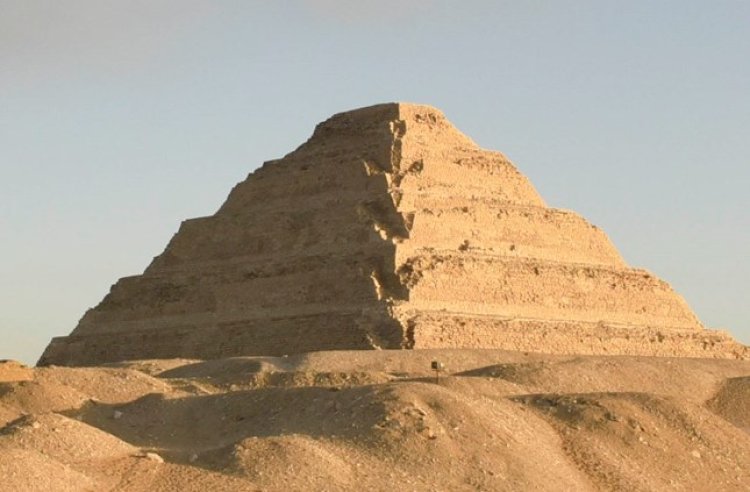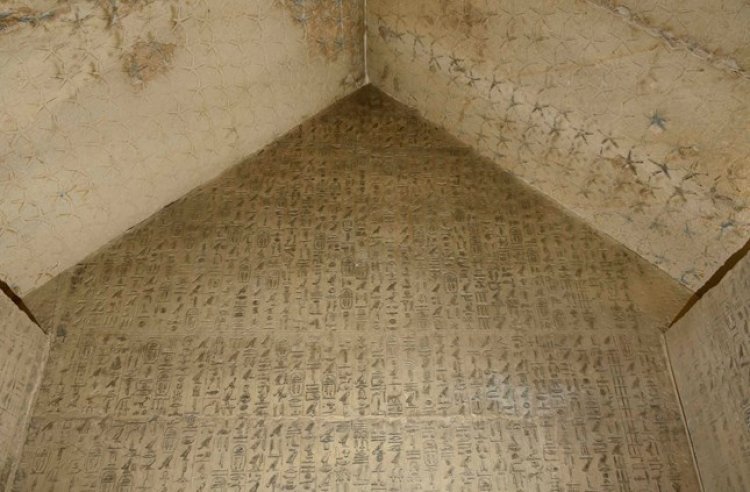The pyramids... the engineering miracle
The pyramids are one of the seven wonders in the world, one of the most beautiful architectural structures made by man throughout history and an unparalleled tourist landmark. The ancient Egyptians built them between 2630 and 1530 BC.
And even though thousands of years have passed since it was built, the pyramids are still the most, the pyramids remain the strongest symbols of Egyptian civilization to this day. And the goal of every visitor to Egypt, as it is also a source of inspiration for art and cultural life in the countries of the Nile. The pyramids were built of huge stones that were transported from Aswan region south of Cairo through the Nile River, which was then reaching the pyramids area.
Among the most famous of these pyramids are the pyramids of Giza (Khufu, Khafre, Menkaure).
Khufu’s pyramid
The Great Pyramid, or better known as the Pyramid of King Khufu (2589-2566 BC), with its original height of 146.5 m, was the tallest building in the world for 3800 years, and it is still one of the Seven Wonders of the Ancient World that remains until now. It took 10 to 20 years to build the pyramid. To this day, we have no confirmed information about how the Great Pyramid was built.
The Great Pyramid was built of local limestone, while in the past it was completely covered with a high-quality limestone cladding. The cladding stones were brought from Tora quarries by boats up to the pyramid. From the inside, the pyramid includes three burial chambers, one of which is cut under the lower rock, and two are at a height inside the building itself, something unique to the pyramid of Khufu that no other pyramid has. The visitor can see the coffin in which King Khufu was lying in the upper room known as the King's Chamber. This room can be accessed through the Great Hall, a corridor with a grandiose tiered ceiling, considered a masterpiece of ancient architecture.
Two large dismantled boats were discovered in pits on the southern side of the Great Pyramid, which were believed to have been used to transport the king's mummy and funerary furniture to the pyramid. The eastern boat has been reinstalled, and it is displayed in the Khufu Boat Museum next to the pyramid and built above the pit in which it was found.
Khafre's pyramid
King Khafre (about 2558-2532 BC), the son of King Khufu, established his hierarchical group on the Giza plateau next to his father’s group. His pyramid appears higher than the pyramid of Khufu because it is on a higher hill, although in fact it is lower in height, reaching about 143.5 m. The nucleus of the pyramid consists of blocks of local limestone, and the top of the pyramid still retains its original covering made of luxurious limestone, which in the past covered the entire pyramid. The Egyptians used to bring it from Tora quarries by boats anchored near the pyramid.
The mortuary temple of Khafre, at the foot of his pyramid, and its valley temple at the front of the ascending road were the largest among the temples of any other hierarchical group, and they were the best preserved among the temples of the old state. There is another architectural development that occurred during the reign of Khafre, which is the complexity of the design of those temples, as the elements that make up his mortuary temple became the new standard that was followed in the old state after him, while the Khafre group was unique in the presence of a huge statue next to the Valley Temple that had no parallel, which is the statue of the great sphinx.
As for the Valley Temple, it consists of huge blocks of limestone covered with granite, while the floors are covered with alabaster, and its wide courtyard includes monolithic columns of granite. The niches carved in the walls of the square were arranged symmetrically along the walls to include statues of the king, some of which are currently on display in the Egyptian Museum in Tahrir, one of them is the famous granite statue of Khafre with the falcon Horus standing behind his head, a statue that is considered one of the masterpieces of ancient Egyptian art.
Menkaure's pyramid
King Menkaure (about 2532 - 2503 BC) built the third pyramid on the Giza plateau. He is the son of Khafre and the grandson of Khufu, with the small base area of the pyramid. The height of the original pyramid is 65 meters, making the pyramid of Menkaure the smallest. This small size was due to several factors, including the small area remaining on the Giza plateau, and the materials used in the outer casing of the pyramid of Menkaure, where his predecessors used limestone to cover their pyramids, while Menkaure used granite brought from Aswan, more than 800 km from Giza. And that material was much harder than limestone to ship and transport. However, only the lower quarter of the pyramid is covered with granite, while the rest of the pyramid is covered with limestone.
Just as it was next to the Great Pyramid, three smaller pyramids can be seen next to the pyramid of Menkaure, those pyramids that were used to bury the queens of his time. However, his pyramid has not been discovered, but it is believed that the largest pyramid of the three queens was the pyramid.
Menkaure died before the construction of his pyramid was completed, as not many blocks of the granite cladding of the pyramid had been polished. The mortuary temple and the private valley temple were supposed to consist of huge blocks of limestone covered with granite, but they were actually built using white adobe. Despite the weakness of those materials, Menkaure's canonization continued for another 300 years after his death.
There are other famous pyramids in the ancient Egyptian civilization:
The red pyramid
It is the highest among the pyramids of Dahshur, and it is called "The Red" due to the red color of its stones (stones from local quarries). It was covered with a layer of white limestone from the Tora quarries, south of modern Cairo, which was removed in the Middle Ages for reuse in construction. The Red Pyramid is the third largest Egyptian pyramid after the pyramids of Khufu and Khafre in Giza.
The Red Pyramid is one of the three pyramids built by King Sneferu after the curved pyramid, located a kilometer to the south, and the third pyramid which is called the Pyramid of Meidum.
The visitor can enter the pyramid from the entrance on the north side, which leads to a corridor (one meter high and one meter wide). Then it descends into another portico into a chamber with a vaulted ceiling, like an inverted staircase. Then another corridor leads to a second chamber located right in the middle of the pyramid at the western side of that chamber. To the south of it, there is a passage to a third chamber believed to have been the burial chamber of the pyramid.
The curved pyramid is one of the pyramids built by King Sneferu, the first king of the Fourth Dynasty. It was called "the curved" because of the refraction in it, due to changing the angle of its construction, which is an engineering problem in the design. As the construction of the pyramid began at an angle of 55 degrees, but it had to be adjusted to 43 degrees due to the excessive load in the stones, which led to instability. Although the king's engineers made modifications to the curved pyramid, they built a new pyramid a short distance away at Meidum, which is known as the Red Pyramid. The curved pyramid is the transitional stage between the construction of the step pyramid of King Djoser in Saqqara and the completed pyramids at Giza.
The curved pyramid has two entrances, one of which is on the northern side with modern wooden stairs, and the other entrance is high on the western side of the pyramid. Each entrance leads to a room with a vaulted ceiling, giving the impression of a gradation in height. The room after the north entrance is below ground level. As for the room at the western entrance, it is built on a height inside the curved pyramid.
Step Pyramids of Djoser
The step pyramid of King Djoser is one of the most famous monuments in Egypt, and it an important historical turning point in the ancient Egyptian funerary monuments, as well as a revolution in stone architecture and royal burial. In addition to its huge size, it is the first pyramid built by the ancient Egyptians and the oldest known stone building.
The age of building the step pyramid dates back to the beginning of the Third Dynasty, during the reign of King Natracht (2627-2648 BC), now known as Djoser, which is the most common.
Prior to his reign, Egyptian kings and elites were buried in mastabas. The term “mastaba” refers to a type of mortuary structure that was generally rectangular and built over a burial pit, which was underground. The step pyramid consists of six mastabas that give the stepped shape, and perhaps the engineer Imhotep was the owner of this great innovation.
At one end of the hierarchical group is a building known as the Southern Cemetery, which is considered a symbolic tomb of King Djoser that may have reflected his role as king of Upper and Lower Egypt. The pyramidal group contains some distinctive elements. The two courtyards in front of the pyramid were to hold a dam celebration, a celebration symbolizing the rejuvenation of the king and the renewal of his strength. The stone chapels on the eastern side of the courtyard were used in this celebration, ensuring that the king continued his rejuvenation forever.
Unas' pyramid
The pyramid of Unas dates back to the Fifth Dynasty, and despite its small size, it is of great importance because it contains the first funerary texts known as the Pyramids texts. These texts were engraved on the walls of the burial chamber to help the deceased king on his journey to the other world.
Like most pyramids, the hierarchical complex of King Unas includes two temples (the Mortuary Temple and the Valley Temple) linked by a long ascending road. The remains of the Valley Temple can be seen at the modern entrance to the Saqqara site, in addition to the remains of the ascending road, whose walls were elaborately decorated, although they were removed and reused by later kings. Despite this, what remains of it still provides visitors to the area an important glimpse of what it was like in the past.
It was built during the reign of King Menkaure, the Egyptian pharaoh of the Fourth Dynasty of the Old state, the son of King Khafre in the era of the ancient Egyptians. He married the princess (Khamer Ar Nabta II). The Pyramid of Menkaure, the smallest of the pyramids of Giza, is located on the south side of it is the Pyramid of Khafre and the Great Pyramid of Khufu in the Giza Cemetery. It is a tenth the size of the Great Pyramid. The pyramid was built of granite and limestone. The original pyramid is 65 meters high. It was the smallest of the three main pyramids in the Giza cemetery. Now the height of the pyramid is 61 meters, the length of its base is 108 meters, the angle of inclination is 51 degrees, and the temperature inside the pyramid is about 20 degrees Celsius. The establishment date of the pyramid is unknown, because the reign of Menkaure has not been determined precisely, but it may have been completed in the twenty-sixth century BC. Richard Weiss, who visited Egypt for the first time in 1835, discovered the remains of a wooden human sarcophagus inscribed with Menkaure's name and containing human bones.








